Some leagues, particularly in Europe, are covered in such granular detail that scouting a player starts almost as soon as they can walk. These leagues are saturated with attention, youth teams are constantly reviewed and dissected in search of value as it gets harder and harder to come by.
Others, however, due to location, funding, quality or a number of other reasons, don’t get the same level of attention from the footballing world. These leagues operate under the radar, at a level unbeknownst to the world, written off as a distant land where no scout should venture.
Now I’m not suggesting that Mexico is as desolate as I’ve spoken about above. In fact, quite the opposite. But when people talk about the South American leagues, they talk of the flair in Brazil, the guile in Argentina or the robustness of Columbia – Mexico is rarely the focus of conversation. In recent years, however, the Liga MX has seen an increased influx of South American players who have raised the level of football yet again. This multinational contingent has attracted more fans, which in turn generated income, and so began the wheel of the commercial football market.
In this data analysis, we look at the talent hidden in the Liga MX, providing an analysis of the prospects emerging in this exciting league.
An Emerging Market
According to ESPN, the Liga MX is the most-watched football league in the USA, attracting a peak of 4.8 million viewers in the US for the clash between América and Cruz Azul. This level of interest has sparked conversations of a lucrative merger to take place between the MLS and Liga MX, in a deal that would again raise the profile of the Central-American competition.
Whether that deal goes ahead at this stage is speculative; however, the one thing that can be seen is the changing landscape in the league as it’s global reputation grows.
The data used in the analysis is taken from Wyscout, where metrics have been collected from a range of exciting attacking players within the Liga MX. Only players 30 and under are included and each player has played at least 700 minutes of football in the 2019/20 Liga MX season.
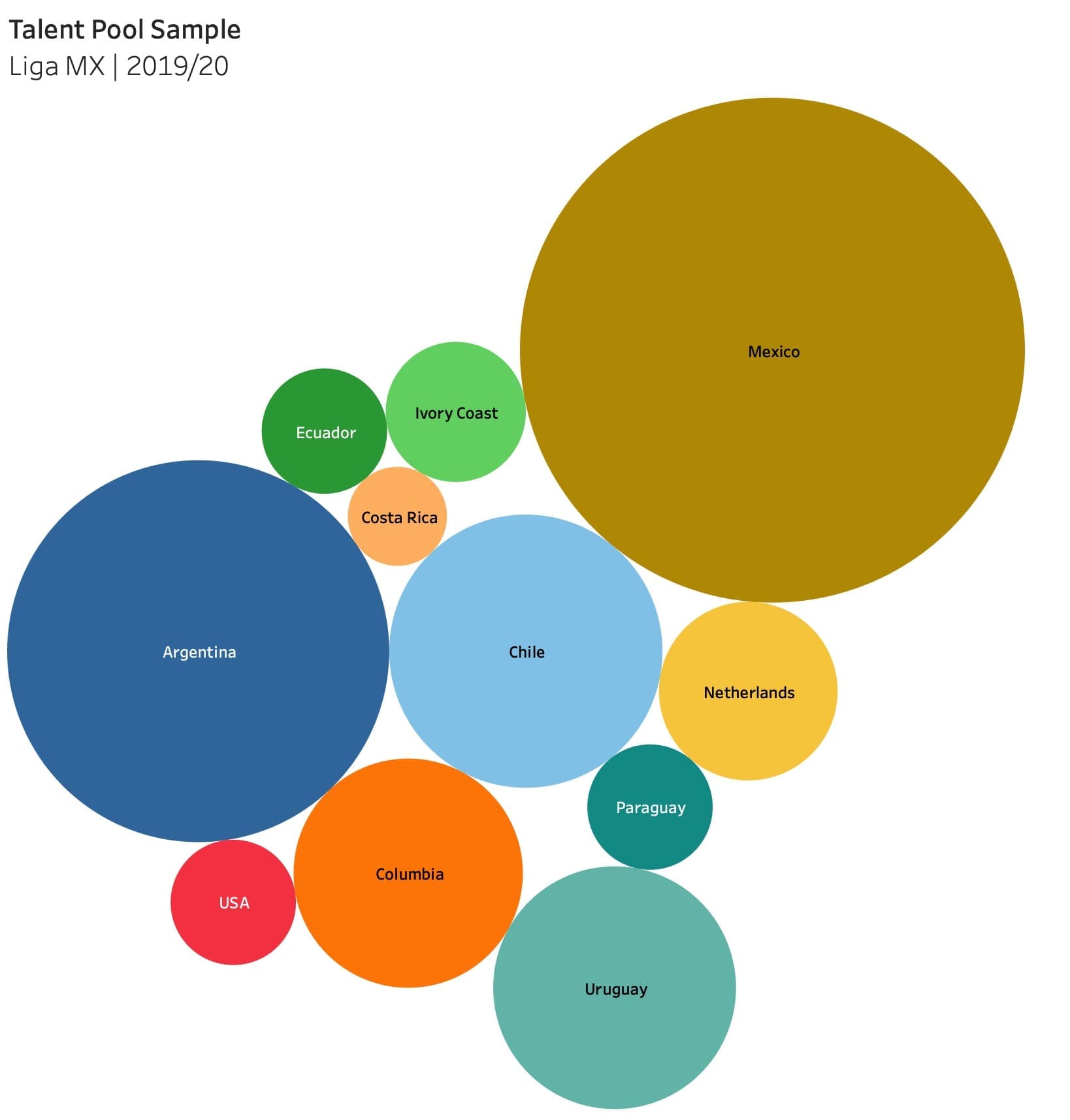
The graph above has been created using this data. It depicts the range of nationalities now gracing the league with their skills. The size of each bubble is indicative of the player’s market values from each nationality, taken from transfermarkt. Though it isn’t absolute, this sample gives us an indication of the wealth and variety of talent now hosted in the Liga MX.
We can see that the bulk of the players are homegrown, being of Mexican nationality. What is interesting is the variety of South American nationalities who have left their domestic leagues to join the Liga MX. We can see these countries range from Uruguay to Paraguay, with Argentina being the biggest contributor. The final interesting observation is the introduction of European players moving across the Atlantic to ply their trade in this growing competition.
All of this boils down to one thing: opportunity. Liga MX is a league on the up, where transfer values have not yet caught up with the rest of the world. Scouting teams across the world should be turning their attention to this league as a potential opportunity, not just to find great initial market value, but high re-sell opportunities also.
Goal Contribution
Now we have established an understanding of why footballers are seeking to travel to Mexico – not just for Cancun – let’s look into the data.
As mentioned a sample of over 35 Liga MX attacking players, under the age of 31, who have played over 700 minutes of domestic football have been selected for analysis.
The first test measures the player’s goals scored per 90minutes against their Expected Goals per 90 (xG90). The size of the markers is determined by each player’s respective transfer value, seen below.
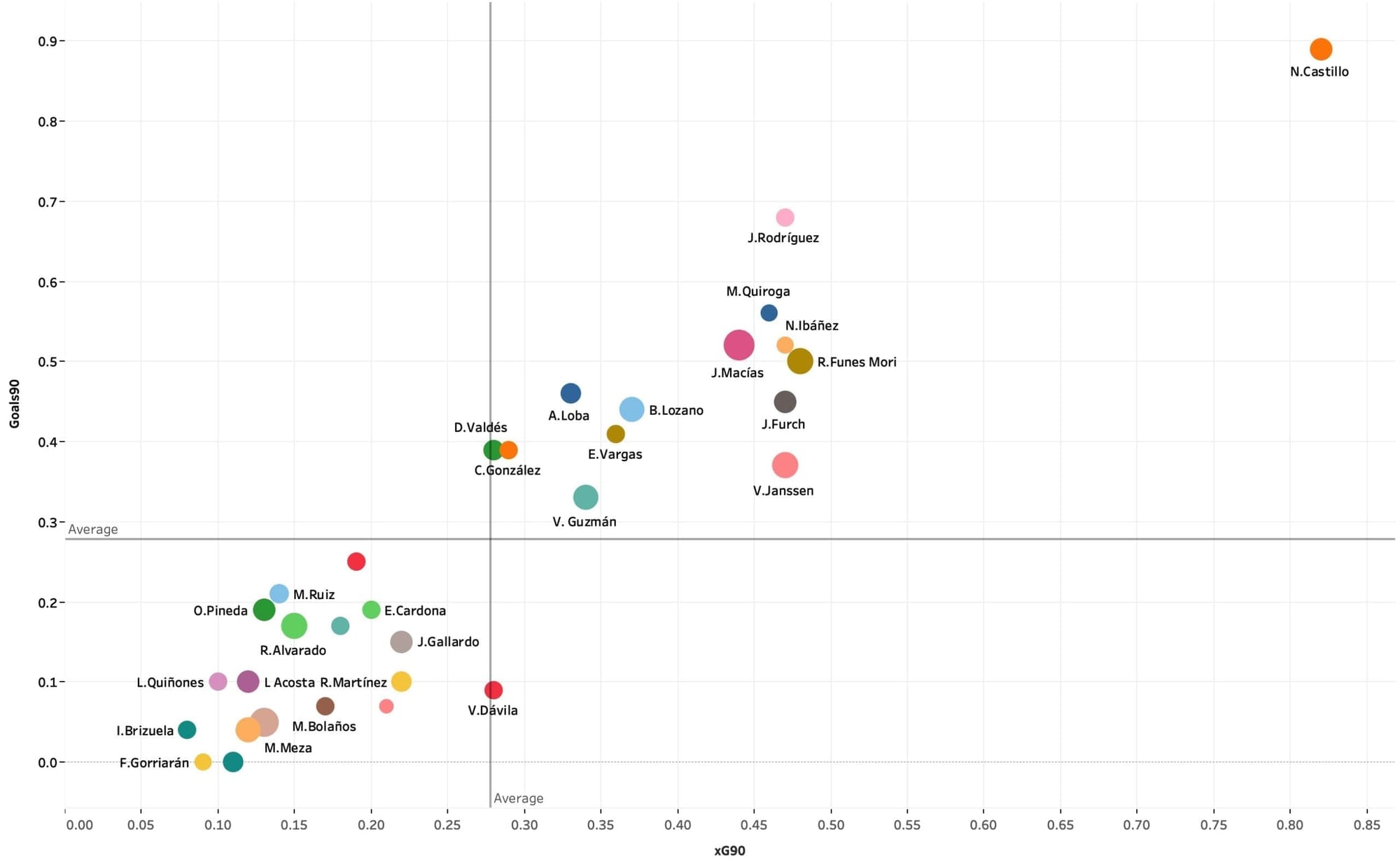
As you would expect, there is a clear correlation in this test, with the R-Squared value reaching 0.85.
Nicolás Castillo of América stands out, achieving an impressive 0.89 goals per 90, which is in line with his xG90 of 0.82. The Chilean is an established centre-forward, who at 27 years of age is in the peak of his career. With a value of $5.28million, this player represents value for money, despite little sell-on potential.
Youngster José Macías, who is perhaps the most exciting prospect in the league, also achieves impressive umbers. The 20-year-old averaged 0.52 goals per 90 – roughly a goal every other game – which for a prospect is a solid return. He is also overachieving against his xG90, indicating a level of clinicalness that may be worth keeping an eye on. Transfermarkt values the Guadalajara striker at $9.9million dollars, which looks like a bargain if the youngster continues to develop his goal-scoring habit.
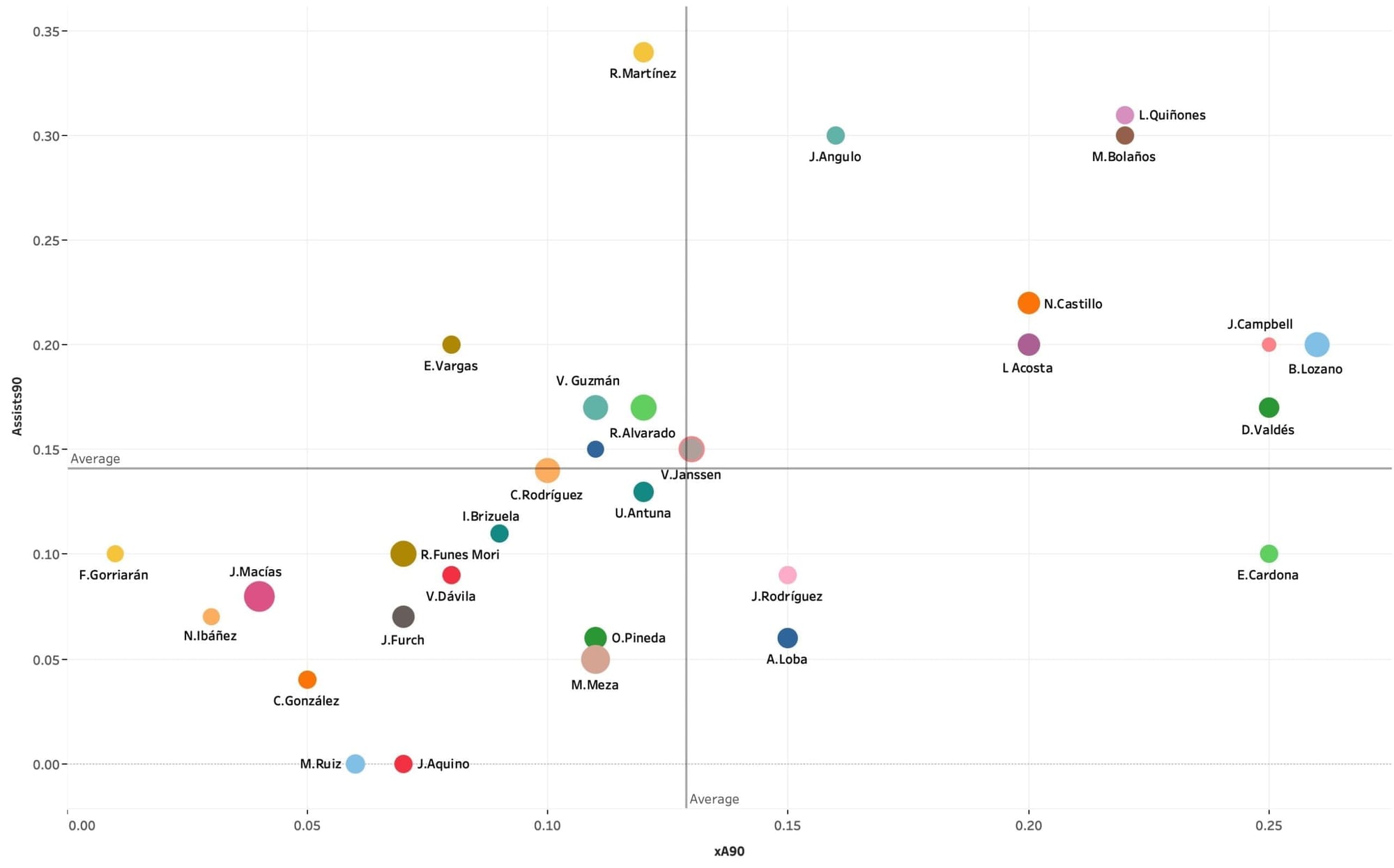
The next graph is similar to the first but instead measures goal contribution in terms of assists, where assists per 90 are cross-referenced against expected assists per 90 (xA90).
Castillo ranks highly in this test also, however, there are two other particularly noteworthy players. Firstly, Roger Martínez is outperforming his peers, achieving 0.34 assists per 90. The Columbian is overachieving compared to his xA of just 0.12, indicating that instead of a creative force, Martínez has experienced an influx of goals from passes/crosses that don’t warrant such an outcome.
Secondly, on the other side of the coin, is Edwin Cardona. This season the 27-year-old would have expected to average 0.25 assists per 90 based on his quality of passing, however, thanks to some poor finishing and variance averages just 0.1 assists per 90.
Creativity
This section looks beyond direct goal contributions from the players and focuses on other aspects in the attacking phase. This is important because there is a lot of football played before the final two actions in the game are undertaken. These phases of play are equally as important and therefore, using a range of metrics, this section captures the players who excel in the other aspects of the attacking phase.
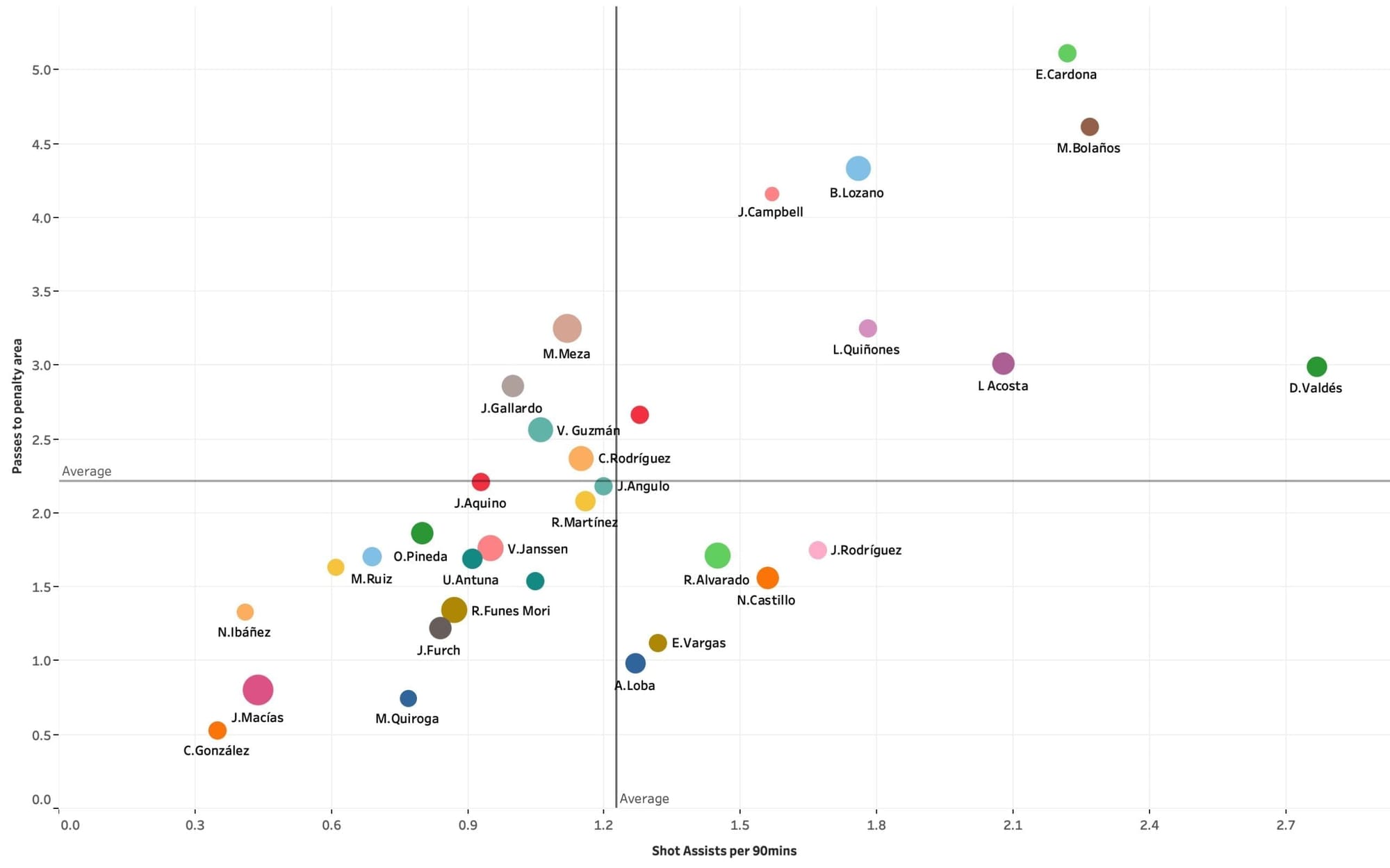
The test above measures shot assists against the number of passes each player made into the penalty area per 90. These two metrics remove the weight of assists, instead showing the levels of penetration within the attacking player’s passing range.
Cardona again stands out as the most creative, averaging 5.11 passes into the penalty area and 2.22 shot assists per game. These numbers indicate this player is an incisive playmaker, who looks forward often to penetrate defences.
Another player similar to this is Miler Bolaños of Club Tijuana. The 29-year-old striker is at the peak of his career and valued at just $3.52million. Though he didn’t stand out as a goal machine in the first test, this test shows he possesses creative abilities which can be used as a second striker or number ten. The Ecuadorian averages 4.61 passes to the penalty area per 90 and 2.27 shot assists per game.
From a creative perspective, the statistics don’t look great for youngster Macías, who averages just 0.8 passes into the penalty box per 90 and 0.44 shot assists per 90. From a recruitment perspective, this indicates he is more of a striker who isn’t involved heavily in buildup play, choosing to get himself into the most dangerous positions to score over creating for others.
The graph above is a good gauge of the mindset of a player and their playing style. It highlights the players looking to create for others and how often they are playing forward. What it doesn’t show is the risk level of their passing and how successful they are. This has been analysed below.
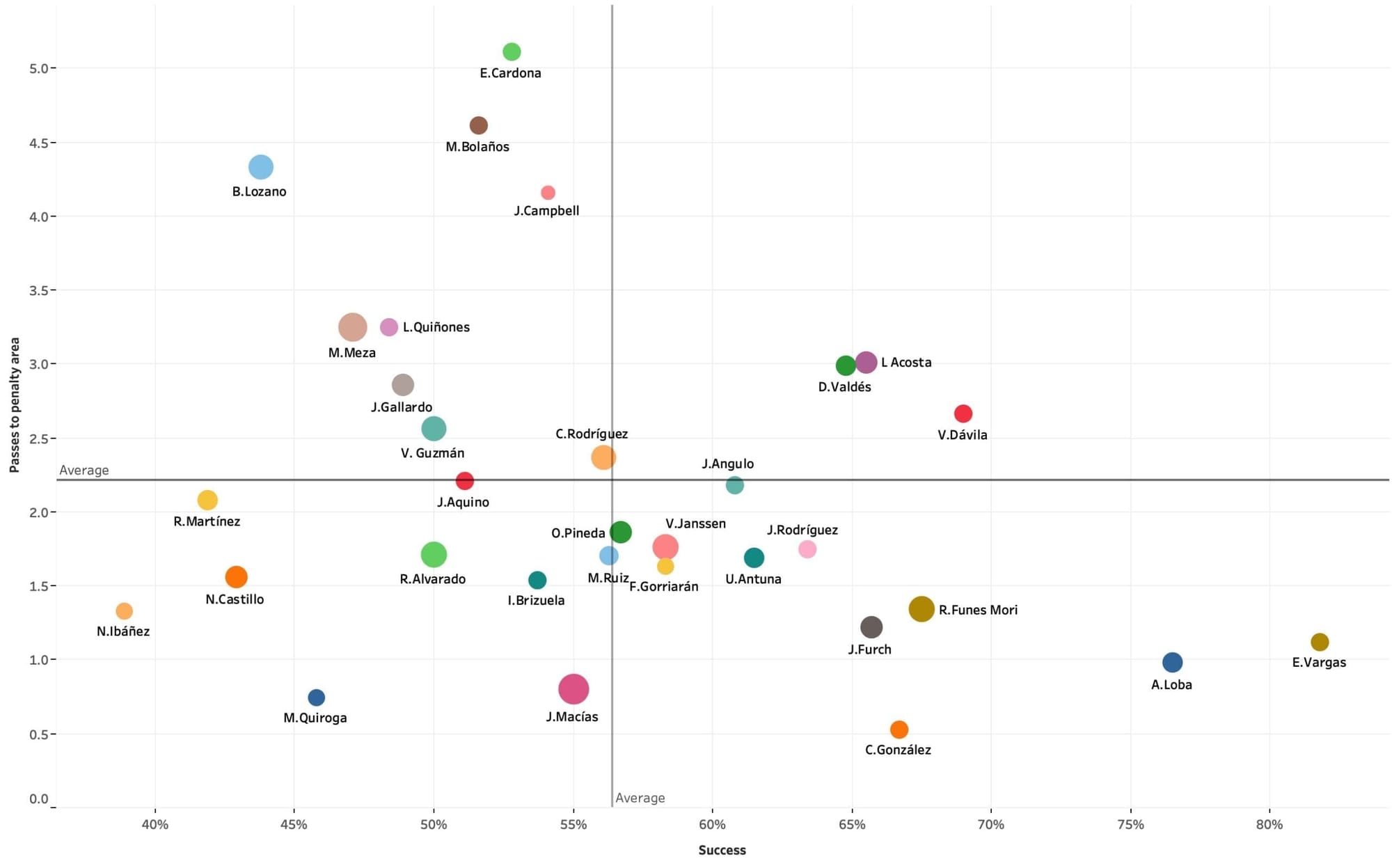
This time passes to the penalty area have been cross-referenced with the player’s success rate in playing these passes. This measures both ability in finding and choosing the right pass and also the technical ability of actually executing it.
This gives a slightly different picture. Cardona and Bolaños, despite their high frequency, are actually below average in terms of their success rate, averaging 53% and 52% respectively. This tells us they play with a level of risk around the box which is required to penetrate tight defences. It would not suit a team looking to control possession at a low tempo by keeping possession.
Aké Loba sits at the opposite end of the scale. The 22-year-old Ivorian has a much higher success rate (77%), however, averages just 0.98 passes into the penalty area. This indicates a level of safety to the player’s passing that is useful to build prolonged attacking spells, but not for chance creation. The youngster only averages 1.27 shot assists per game, which is in line with the penetration levels shown in his passing metrics.
Dribbling
The next section analyses each player’s ability to travel with the ball at their feet. This is a fundamental technical skill that is required at a high level in both the attacking phase – to break down tight defensive structures by taking on a man – and in the transition phase, when looking to break quickly and clinically upfield to score on the counter.
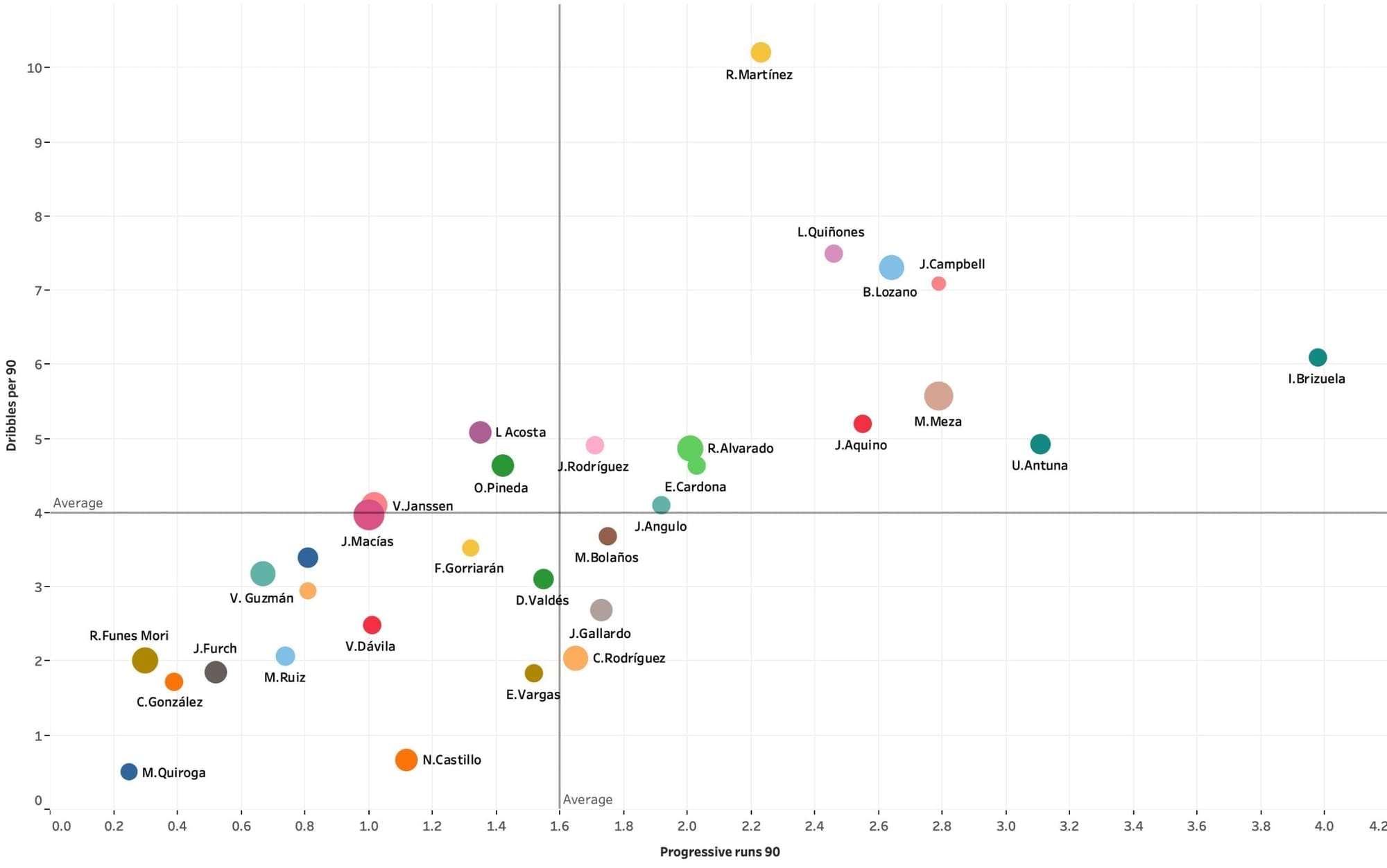
The test above measures each player’s average frequency of dribbles per 90 against their progressive runs made per 90.
A progressive run is defined by Wyscout as:
A run that moves the ball considerably forward. The minimal requirement for a progressive path progression towards an opponent goal is:
- 30 metres, if starting and finishing points are in players half
- 15 metres, if starting is in own half and finishing points is in the opposition half
- 10 metres, if starting and finishing points are both in the opposition half
Again Martínez tops the list. The 25-year-old Columbian averages an impressive 10.21 dribbles and 2.23 progressive runs per 90miuntes. These statistics highlight the player’s ability and confidence on the ball and demonstrates a playing style that would suit teams who try to isolate defenders in 1vs1 scenarios. Valued at just $5.5million, this player represents good value in relation to his impact on the field.
Winger Isaac Brizuela also stands out for his ball progression. The 29-year-old appears adept at moving the ball through phases of play as a ball carrier, averaging 3.98 progressive runs per 90. This is a useful technical attribute for a team looking to play in transition, where there is an increased reliance on individuals moving the ball through phases quickly and accurately.
Ex-Premier League man, Joel Campbell, who had a short spell at Arsenal, also features highly on the list. The Costa Rican averages 7.09 dribbles per 90, including 2.79 progressive dribbles per 90 at Club León.
Again, the test above is a good measure of mindset, confidence, and playing style. However, the success rate is not apparent. This is shown below.
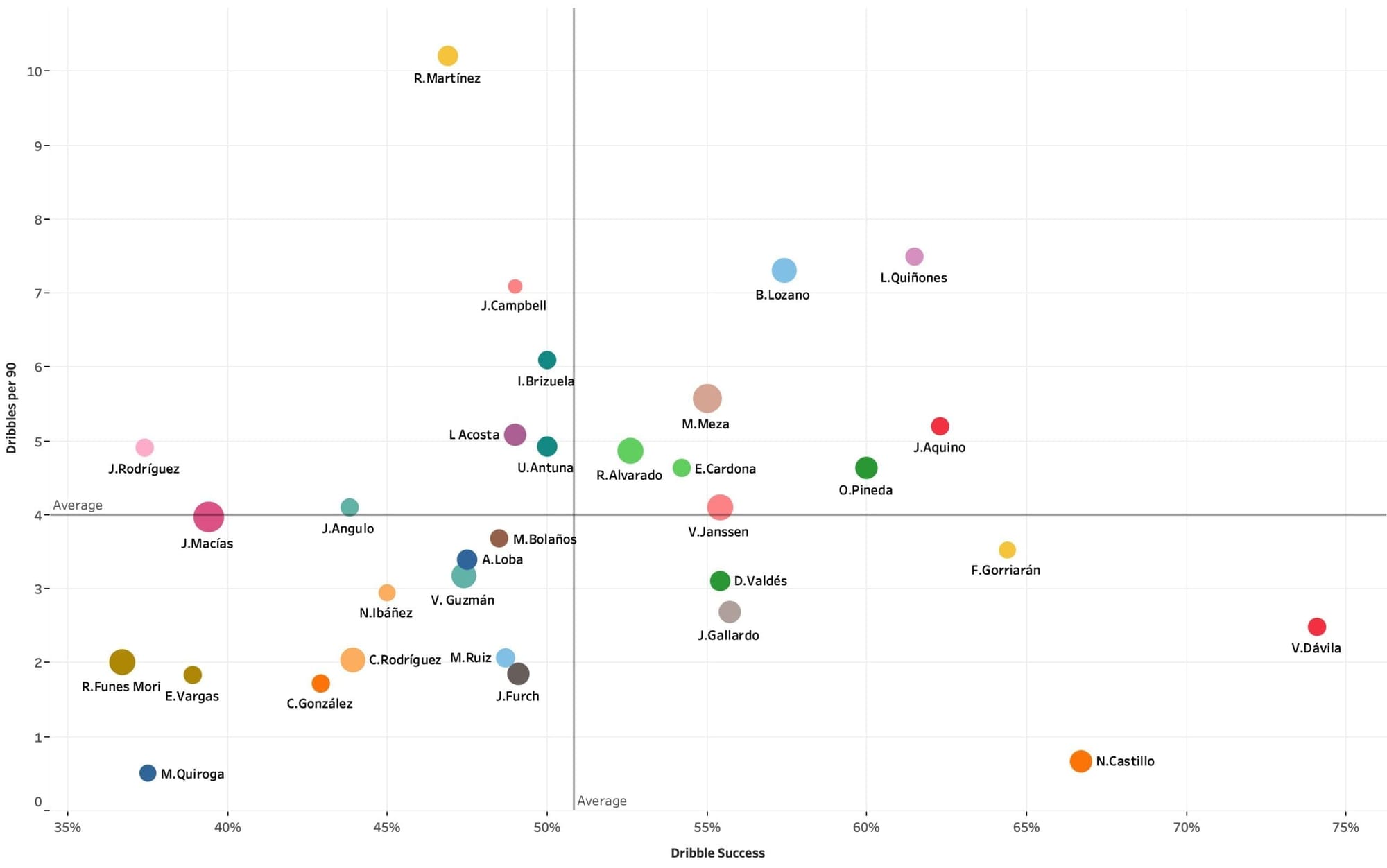
The graph is similar to the first success rate test in that it displays the riskiness of each player’s attempts. Martínez excelled in the first test, but as we can see he is successful just 47% of the time. This isn’t necessarily a bad thing as it indicates he is attempting difficult dribbles to penetrate teams. This also may highlight a tendency to hold onto the ball for too long and miss passing opportunities that would benefit the attack, something further scouting would answer.
Luis Quiñones has featured above average in the majority of the tests in this article. Though never being the best, the 28-year-old Columbian is achieving respectable numbers that indicate an ability to carry the ball and create chances. The winger averages 7.49 dribbles per 90 with a 62% success rate. This demonstrates a maturity level and tactical understanding, allowing him to dribble or pass at the right times. The one area where Quiñones falls below average is his finishing. Therefore, he would suit a team that possessed a finishing striker, who Quiñones could use his technical ability to create for, as opposed to a team that expects the front three to all score goals.
Defending from the front
The final test looks at how each attacking player operates out of possession. Pressing is an integral part of modern football, requiring a high level of fitness, aggression and tactical understanding to be successful. The test below measures each player’s offensive duels per 90 against their recoveries made in the opponent’s half per 90 in an attempt to highlight the best players out of possession.
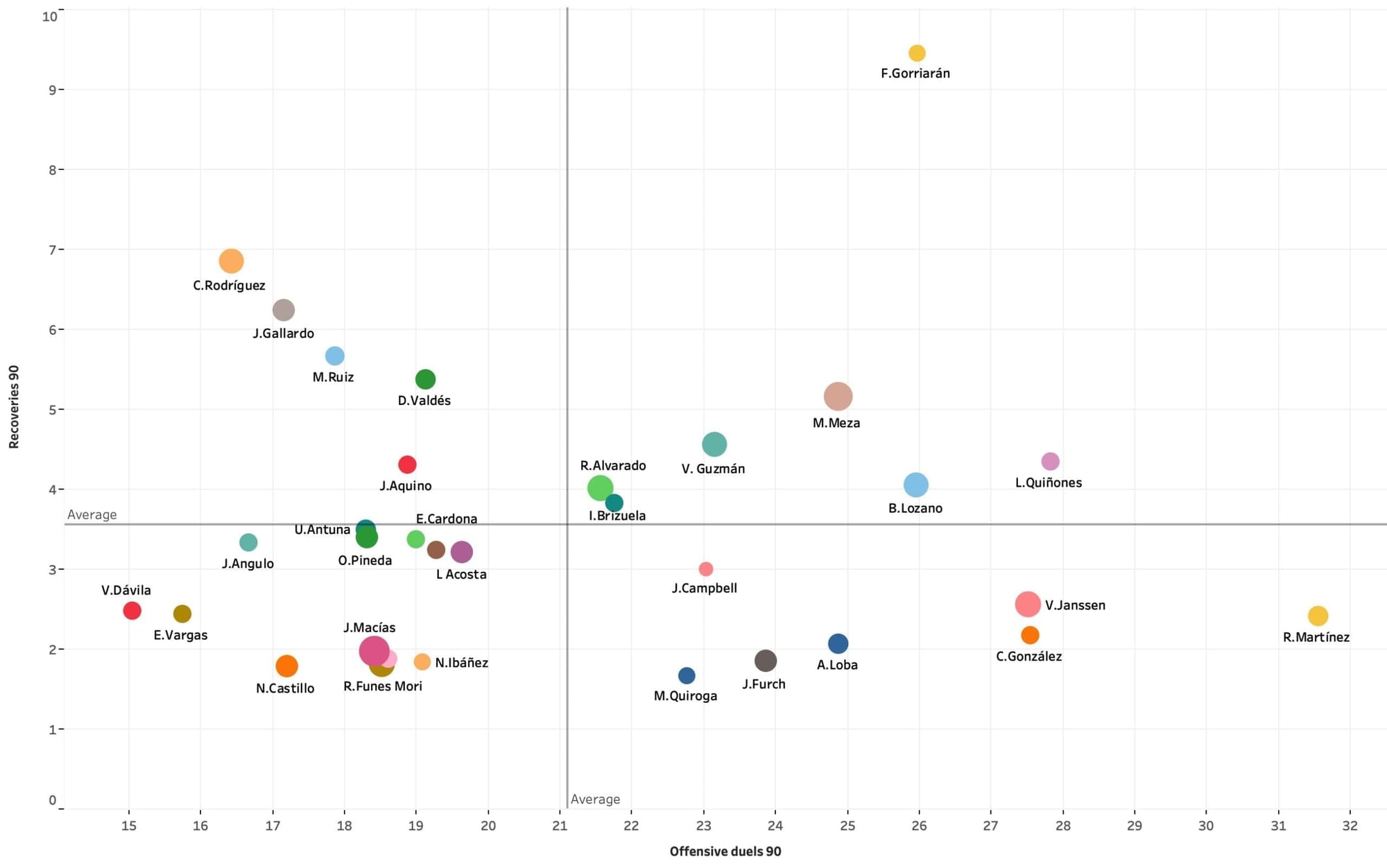
There is a clear standout in this test: Fernando Gorriarán. The 29-year-old midfielder is far ahead of his rivals averaging 25.97 offensive duels and 9.45 recoveries per 90. This will be in part down to his slightly deeper positioning; however, it highlights a player who would be useful in a side that engages the opponent frequently and higher up the pitch.
Carlos Rodríguez is also worth a mention, averaging 6.85 recoveries per 90 in the opposition half. Despite his mediocre numbers for goalscoring, this metric gives us an idea that the Mexican is a physical striker whose skill set lies in ball recovery. From a recruitment standpoint, he would suit being accompanied by fast players in offensive transition to compliment his recovery abilities.
Final Thoughts
This tactical analysis has shown us that the first tier of Mexican football is now a potential talent pool where teams can obtain quality players at a reasonable price. We have measured a sample of the top attacking talent across the league and highlighted those who excel in each area. Using the results we have provided an analysis of what sort of team each player may be most adaptable to.
Though a player should never be signed using just data, as there are a multitude of other factors to consider when buying a player. This analysis does, however, provide an insight into the best attacking talent in the league and measure this against their age and value in an attempt to show the emergence of quality at a good price in the Liga MX to look at scouting further.

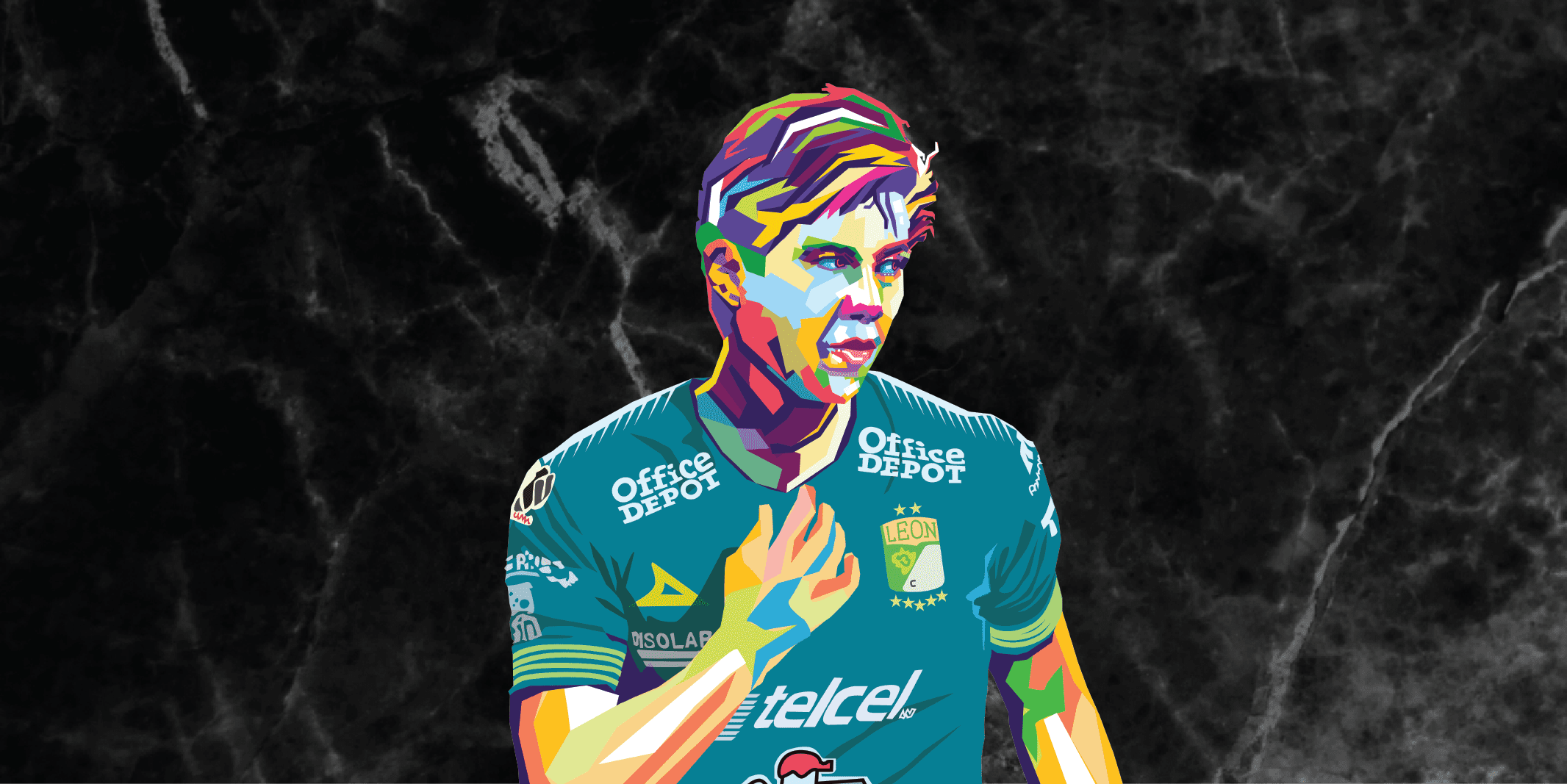



Comments